|
|
|
Sort Order |
|
|
|
Items / Page
|
|
|
|
|
|
|
| Srl | Item |
| 1 |
ID:
170217
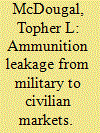

|
|
|
|
|
| Summary/Abstract |
The increase in the accessibility of firearms and ammunition represents a key factor of destabilization in many countries. It is also commonly associated with an escalation in intensity and organization of collective and interpersonal violence. In some cases, arms are illegally transferred via diversion from existing stores. In this article, we consider the leakage from military to civilian markets as an important source of ammunition available to civilians in Haiti. We employ a unique section-quarterly panel of ammunition prices on the Haitian civilian market over the period July 2004–July 2012. These data are combined with publicly available monthly data on authorized ammunition shipments to the country registered by the United Nations (UN) and Haitian National Police (HNP). We use a standard time-series Ordinary Least Squares (OLS) model to show that the exogenous shocks of UN- and HNP-ordered ammunition exert measurable downward pressure on civilian ammunition markets, which we calculate in terms of adjusted predictions and partial elasticities of demand. These effects constitute econometric evidence that the firewall that should in theory have separated military and civilian markets in Haiti partially broke down. We conclude with a suggestion for using this model to help estimate the specific size of the leakage.
|
|
|
|
|
|
|
|
|
|
|
|
|
|
|
|
| 2 |
ID:
109269
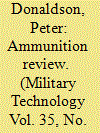

|
|
|
| 3 |
ID:
001056
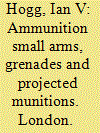

|
|
|
|
|
| Publication |
London, Greenhill Books, 1998.
|
| Description |
144p.
|
| Standard Number |
1853673234
|
|
|
|
|
|
|
|
|
|
|
|
Copies: C:1/I:0,R:0,Q:0
Circulation
| Accession# | Call# | Current Location | Status | Policy | Location |
| 040553 | 355.825/HOG 040553 | Main | On Shelf | General | |
|
|
|
|
| 4 |
ID:
123935
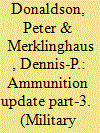

|
|
|
|
|
| Publication |
2013.
|
| Summary/Abstract |
The article reports on developments in large caliber gun ammunition with long range and precision guidance. BAE Systems, Oto Melara and Raytheon are some of the defense companies that have successfully tested systems that satisfy these requirements. ATK is another, being the manufacturer of large-caliber tank ammunition for the U.S. military. BAE has tested its Long-Range Land Attack Projectiles, while Israel Military Industries manufactures the 155mm Super-High-Explosive artillery projectile.
|
|
|
|
|
|
|
|
|
|
|
|
|
|
|
|
| 5 |
ID:
061820
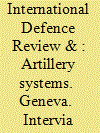

|
|
|
|
|
| Publication |
Geneva, Intervia Publication,
|
| Description |
110p.
|
|
|
|
|
|
|
|
|
|
|
|
Copies: C:1/I:0,R:0,Q:0
Circulation
| Accession# | Call# | Current Location | Status | Policy | Location |
| 020989 | 358.17182/INT 020989 | Main | On Shelf | General | |
|
|
|
|
| 6 |
ID:
109427
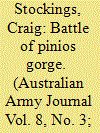

|
|
|
| 7 |
ID:
134025
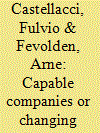

|
|
|
|
|
| Publication |
2014.
|
| Summary/Abstract |
The paper presents an analysis of the factors explaining the export performance of firms in the defence sector. We focus on the case of Norway, and make use of two complementary methodologies: the first is based on econometric firm-level data analysis for the whole population of defence companies, and the second is based on qualitative case study research on the three most important defence export products (weapon stations, ammunition and electronics). Our empirical results highlight the importance of four major success factors for exporting firms: (1) the participation in offset agreements; (2) the ability to focus on their set of core competencies; (3) their R&D activities and interactions with the public S&T system; and (4) demand opportunities and, relatedly, user-producer interactions.
|
|
|
|
|
|
|
|
|
|
|
|
|
|
|
|
| 8 |
ID:
175019
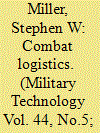

|
|
|
| 9 |
ID:
109268
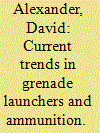

|
|
|
| 10 |
ID:
097638


|
|
|
| 11 |
ID:
132234
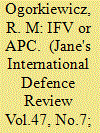

|
|
|
|
|
| Publication |
2014.
|
| Summary/Abstract |
Tracked armoured vehicle were originally produced to enable infantry to follow tanks and support them after dismounting, but shifting operational trends are overseeing an evolution in tracked armoured vehicle developments.
|
|
|
|
|
|
|
|
|
|
|
|
|
|
|
|
| 12 |
ID:
079450
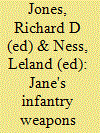

|
|
|
|
|
| Publication |
Surrey, Jane's Information Group, 2007.
|
| Description |
923p.
|
| Standard Number |
9780710628015
|
|
|
|
|
|
|
|
|
|
|
|
Copies: C:1/I:0,R:0,Q:0
Circulation
| Accession# | Call# | Current Location | Status | Policy | Location |
| 052789 | 623.4/JON 052789 | Main | On Shelf | General | |
|
|
|
|
| 13 |
ID:
085083
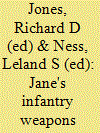

|
|
|
|
|
| Edition |
34th ed.
|
| Publication |
Surrey, Jane's Information Group, 2008.
|
| Description |
943p.
|
| Standard Number |
9780710628343
|
|
|
|
|
|
|
|
|
|
|
|
Copies: C:1/I:0,R:1,Q:0
Circulation
| Accession# | Call# | Current Location | Status | Policy | Location |
| 054040 | 623.4/JON 054040 | Main | On Shelf | Reference books | |
|
|
|
|
| 14 |
ID:
097983
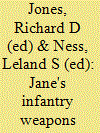

|
|
|
|
|
| Edition |
36th ed.
|
| Publication |
Surrey, Jane's Information Group, 2010.
|
| Description |
957p.
|
| Standard Number |
9780710629081, hbk
|
|
|
|
|
|
|
|
|
|
|
|
Copies: C:1/I:0,R:0,Q:0
Circulation
| Accession# | Call# | Current Location | Status | Policy | Location |
| 055111 | 623.4/JON 055111 | Main | On Shelf | General | |
|
|
|
|
| 15 |
ID:
108839
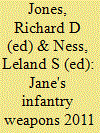

|
|
|
|
|
| Edition |
37th ed.
|
| Publication |
Surrey, Jane's Information Group, 2011.
|
| Description |
983p.
|
| Standard Number |
9780710629470, hbk
|
|
|
|
|
|
|
|
|
|
|
|
Copies: C:1/I:0,R:0,Q:0
Circulation
| Accession# | Call# | Current Location | Status | Policy | Location |
| 056368 | 623.4/JON 056368 | Main | On Shelf | General | |
|
|
|
|
| 16 |
ID:
083387
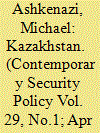

|
|
|
|
|
| Publication |
2008.
|
| Summary/Abstract |
Why does Kazakhstan not have a surplus arms and ammunition policy? Contradictory events and extreme official reticence show instead that the government of Kazakhstan does not know what to make of the issue. Despite its extensive engagement in UN processes, years of prodding from NATO and the OSCE, and the existence of its large legacy arsenals from the Soviet era, attitudes in Astana remain elusive. The Kazakhstan experience shows that for any country to act in regards to surplus arms, at least one of two factors must be present: A recognition that the surplus is a problem, or perception of benefits that can accrue by the disposal of SALW. The case of Kazakhstan exemplifies the importance of addressing two issues: surplus-is-not-a-problem and the nature of national decision-making. Internal dynamics within the Kazakhstan government have relegated the surplus issue into a non-problem.
|
|
|
|
|
|
|
|
|
|
|
|
|
|
|
|
| 17 |
ID:
083382
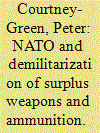

|
|
|
|
|
| Publication |
2008.
|
| Summary/Abstract |
The NATO Partnership for Peace (PfP) Trust Funds originated in September 2000 and now cover destruction of all types of weapons and conventional ammunition. Trust Fund projects originally were developed in countries of the Balkans and the Former Soviet Union, which possessed very large surplus stocks of weapons and munitions, difficult to maintain safely and securely. This article focuses on projects involving demilitarization, especially small arms and ammunition, rather than those involving wider defence reform objectives, such as retraining former military personnel.
There are four fundamental elements of Trust Fund programmes: an appeal for assistance from the host country; fundraising by the lead nation; development and signing of legal and financial agreements; and the execution of the project. The last is normally entrusted to the NATO Maintenance and Supply Agency (NAMSA). Demilitarization of munitions is part of its core business and it has the necessary contracting, project management, and financial management capabilities. There are now 34 eligible countries of the PfP, Mediterranean Dialogue and Istanbul Cooperation Initiatives. Projects have been completed or are planned in Afghanistan, Albania, Azerbaijan, Belarus, Bosnia-Herzegovina, Georgia, Jordan, Kazakhstan, Moldova, Montenegro, Tajikistan, Serbia, and Ukraine. The NATO Trust Fund process has been a successful vehicle for international cooperation. It is likely to continue for several years. There is scope for other international organizations to cooperate with NATO in developing and executing projects of this type.
|
|
|
|
|
|
|
|
|
|
|
|
|
|
|
|
| 18 |
ID:
091227
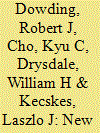

|
|
|
|
|
| Publication |
2009.
|
| Summary/Abstract |
All materials used in large calibre projectiles for tank gun ammunition share a common feature; their design and use requires knowledge of their deformation behaviour up to and beyond failure at high strarain and heating rates.
|
|
|
|
|
|
|
|
|
|
|
|
|
|
|
|
| 19 |
ID:
100375


|
|
|
| 20 |
ID:
083383
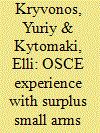

|
|
|
|
|
| Publication |
2008.
|
| Summary/Abstract |
The experience acquired by the Organization for Security and Co-operation in Europe (OSCE) in implementing the UN Programme of Action on Small Arms has demonstrated how complex the problems related to surplus small arms, light weapons (SALW) and conventional ammunition (CA) are. Today, many OSCE states face challenges with large reserves of surplus weapons. Limited national capacities and lack of financial resources have made cooperation and assistance in the OSCE of crucial importance, and made the Organization a significant actor in this area. This essay presents the OSCE assistance mechanism and focuses on two case studies - Belarus and Tajikistan - where major SALW and CA projects have been recently concluded.
The essay finds that destruction is the most desirable method to dispose of surplus small arms and conventional ammunition. It should be advocated to avoid leakages of weapons from legal market to 'grey' and illegal spheres. Because of the risks of diversion and the threats that surplus stocks may pose to human and environmental security, the essay argues that surplus stocks should be given priority attention in national policy-making.
Stronger international norms and standards should be agreed upon to address the problem properly, based on the already existing provisions set out in agreements adopted inter alia by the OSCE. Providing assistance to states in solving the problems related to SALW and conventional ammunition is also seen of crucial importance. These assistance projects should be carefully planned and effectively implemented, and the essay presents a series of factors that could be considered in this regard.
|
|
|
|
|
|
|
|
|
|
|
|
|
|
|
|
|
|
|
|
|